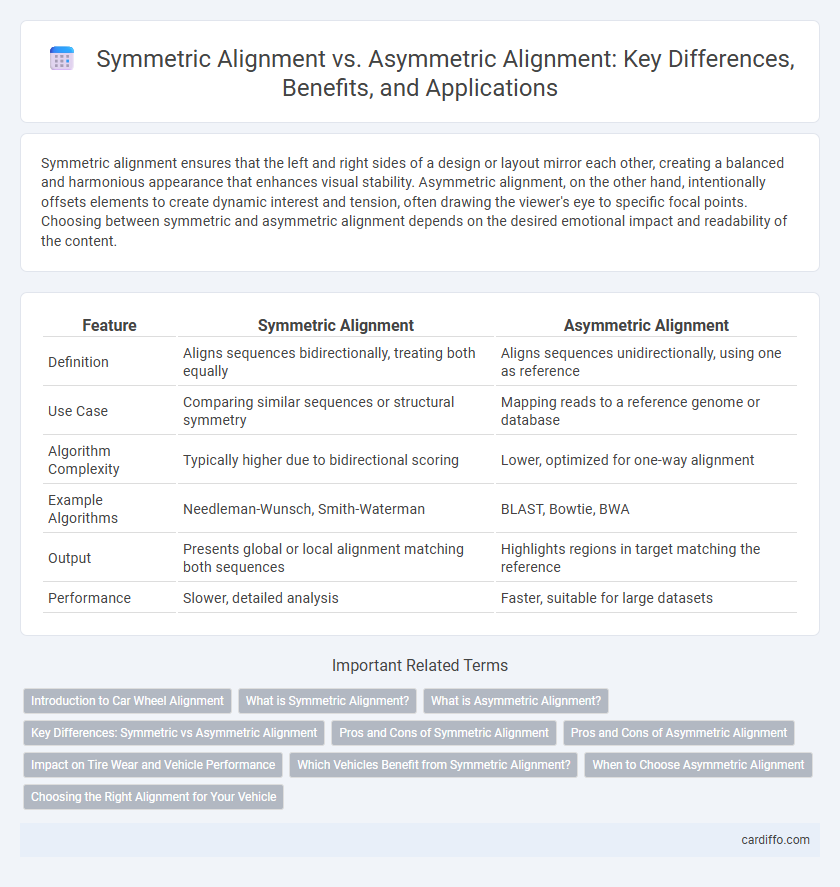Symmetric alignment ensures that the left and right sides of a design or layout mirror each other, creating a balanced and harmonious appearance that enhances visual stability. Asymmetric alignment, on the other hand, intentionally offsets elements to create dynamic interest and tension, often drawing the viewer's eye to specific focal points. Choosing between symmetric and asymmetric alignment depends on the desired emotional impact and readability of the content.
Table of Comparison
| Feature | Symmetric Alignment | Asymmetric Alignment |
|---|---|---|
| Definition | Aligns sequences bidirectionally, treating both equally | Aligns sequences unidirectionally, using one as reference |
| Use Case | Comparing similar sequences or structural symmetry | Mapping reads to a reference genome or database |
| Algorithm Complexity | Typically higher due to bidirectional scoring | Lower, optimized for one-way alignment |
| Example Algorithms | Needleman-Wunsch, Smith-Waterman | BLAST, Bowtie, BWA |
| Output | Presents global or local alignment matching both sequences | Highlights regions in target matching the reference |
| Performance | Slower, detailed analysis | Faster, suitable for large datasets |
Introduction to Car Wheel Alignment
Car wheel alignment ensures tires meet the road at the correct angle for optimal vehicle handling and tire longevity. Symmetric alignment adjusts toe, camber, and caster angles equally across both wheels on an axle, maintaining uniform tire contact and reducing uneven wear. Asymmetric alignment customizes these angles differently for each wheel, compensating for suspension design variations and enhancing performance under specific driving conditions.
What is Symmetric Alignment?
Symmetric alignment refers to the process where two datasets or entities are aligned in a way that both contribute equally to the transformation, ensuring a balanced correspondence. This method is commonly used in image registration and natural language processing to achieve mutual optimization, minimizing discrepancies from both perspectives. Symmetric alignment enhances accuracy and consistency by treating each entity without bias during the alignment procedure.
What is Asymmetric Alignment?
Asymmetric alignment occurs when one tectonic plate subducts beneath another at a convergent boundary, resulting in unequal forces and motion between the plates. This type of alignment often leads to the formation of deep ocean trenches, volcanic arcs, and significant seismic activity due to the differential movement. Unlike symmetric alignment, where plates move toward each other with similar size and properties, asymmetric alignment involves distinct plate characteristics and varying rates of subduction.
Key Differences: Symmetric vs Asymmetric Alignment
Symmetric alignment evenly distributes forces or data across a system, ensuring balanced performance and uniform stress management. Asymmetric alignment directs forces or data unevenly, optimizing for specific conditions or components but potentially causing imbalance elsewhere. Key differences include load distribution patterns, impact on system stability, and suitability for varying operational requirements.
Pros and Cons of Symmetric Alignment
Symmetric alignment ensures equal pressure distribution across surfaces, reducing wear and enhancing component lifespan in mechanical systems. It offers improved stability and balanced load handling, which minimizes vibration and noise during operation. However, symmetric alignment can be less adaptable to systems with uneven forces or asymmetrical designs, potentially requiring more frequent adjustments compared to asymmetric alignment.
Pros and Cons of Asymmetric Alignment
Asymmetric alignment offers enhanced flexibility by allowing different alignment methods for separate components, optimizing performance in complex systems. It can lead to improved precision in specific applications by addressing unique requirements independently, but may introduce increased complexity in design and maintenance. The absence of uniformity can also result in compatibility challenges and higher implementation costs compared to symmetric alignment.
Impact on Tire Wear and Vehicle Performance
Symmetric alignment features equal toe and camber settings on both front wheels, promoting even tire wear and consistent vehicle handling. Asymmetric alignment allows different settings on each side to optimize cornering and stability, potentially improving performance but causing uneven tire wear if not properly managed. Proper alignment calibration balances tire longevity and vehicle responsiveness, directly impacting driving safety and maintenance costs.
Which Vehicles Benefit from Symmetric Alignment?
Symmetric alignment is ideal for passenger cars, SUVs, and light trucks with evenly worn tires and standard suspension setups. Vehicles with front-wheel drive or all-wheel drive systems benefit most from symmetric alignment because it ensures balanced tire contact and uniform wear. This alignment method enhances handling stability, fuel efficiency, and tire longevity on these types of vehicles.
When to Choose Asymmetric Alignment
Asymmetric alignment is preferred when designs require precise control over elements on one side while allowing flexibility on the opposite side, such as in dynamic layouts or adaptive interfaces. It enhances visual interest and guides user attention by creating intentional imbalance that emphasizes key content. This approach is particularly effective in responsive web design, where varying screen sizes demand adaptable yet coherent element positioning.
Choosing the Right Alignment for Your Vehicle
Symmetric alignment ensures all wheels are uniformly adjusted, promoting even tire wear and stable handling, especially beneficial for vehicles with a unibody chassis. Asymmetric alignment offers tailored adjustments to individual wheels, optimizing performance and comfort for specialized driving conditions or uneven weight distribution. Selecting the right alignment depends on your vehicle type, driving habits, and manufacturer specifications to maximize safety and tire longevity.
Symmetric Alignment vs Asymmetric Alignment Infographic

 cardiffo.com
cardiffo.com